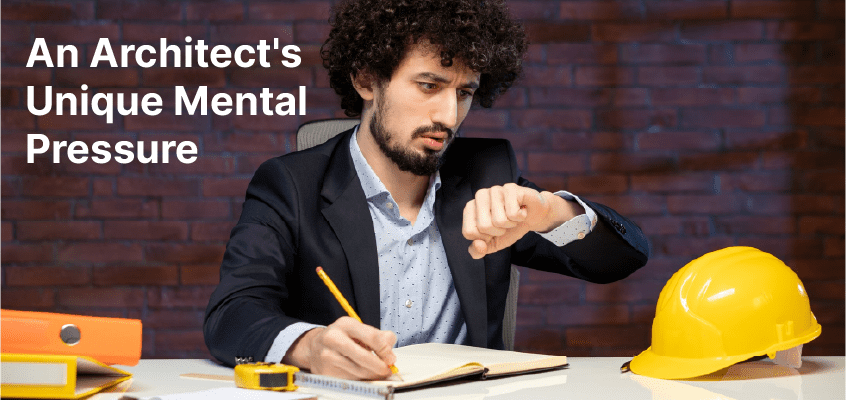Introduction
We all know that architecture is among the most demanding and mentally taxing professions. Architects must continually juggle the demands of their clients, the practicalities of construction, and the often-conflicting pressure of creating a beautiful and aesthetically pleasing structure. But what about the unique mental pressures that architects face?
What are an architect’s unique mental pressures?
Being an architect involves intense mental pressure and stress at various parts of the process.
-
Architects must be creative and innovative while meeting clients’ needs and cultural contexts. They must be able to think through every design aspect, from structural integrity to environmental sustainability.
-
They must also consider the practicality of their designs, such as how the materials used will affect the cost and how the design will perform over time. Additionally, architects must often work with tight deadlines, meaning they must be able to work under pressure and produce high-quality results on time.
-
To make matters worse, architects often face criticism from their peers and clients if their designs need to improve. These factors combined can create tremendous mental pressure for those in this profession.
How good architectural practices affect an architect’s mental health
Quality Assurance
Good architecture practices ensure the system is designed with the best possible quality assurance. It reduces the risk of errors and costs of maintenance. The mental health of an architect decides how it goes.
Scalability
Good architecture practice ensures the system is designed to scale up as needed. It is essential for businesses that plan to grow, as they will need to be able to accommodate an increased amount of traffic or data processing. If an architect is under mental pressure, sometimes it affects scalability.
Security
Good architecture practice ensures the system is designed with the best security measures to protect against malicious attacks. It includes making sure the system is properly patched and updated to stay ahead of new threats. The system is only secure if the worker’s mental stability is ok.
Performance
Good architecture practice ensures that the system is designed to perform optimally with minimal latency. It is essential for businesses that must ensure their systems are always running smoothly and quickly. Poor mental health is a significant hindrance.
Cost Savings
Good architecture practice ensures the system is designed to be cost-effective, which is essential for businesses that need to save money to stay competitive. By creating a system that is easy to use and maintain, companies can save money on maintenance and development costs.
How time constraints affect an architect’s mental health
Time constraints are a familiar challenge architects face in building design and construction.
-
Architects must carefully consider a design’s practical and aesthetic elements while meeting the time constraints set by their clients.
-
Living such an unsustainable life and maintaining an unhealthy work-life balance deteriorates the mental health of architects. Unjust time constraints set up by clients are one of the primary reasons affecting an architect’s mental health.
How does the pressure of maintaining a good reputation affect an architect’s mental health?
Architects must maintain an excellent reputation to be perceived as successful and reliable professionals. It can be challenging as the pressure to deliver high-quality work and exceed expectations grows constantly.
-
Architects must balance the needs of clients, colleagues, and the public while also staying within the code of professional and ethical standards. This constant pressure to maintain a good reputation affects an architect’s mental health.
-
Word-of-mouth recommendations sometimes play a massive role in architects’ onboarding of new clients. To ensure client satisfaction, which would lead to requests, architects must be open to feedback and accept countless client rework proposals. It leads to stress and anxiety.
-
An architect is expected to show up well-dressed and in high spirits even when they do not feel like it. Failure to do so often affects the reputation of the architect, which is anything but fair.
-
It is sometimes complicated for architects to voice their opinions without risking offending the client or seniors. It is another factor that hurts their mental health.
How does the pressure to create something long-lasting and memorable affect an architect’s mental health?
Creating something long-lasting and memorable is daunting for architects [3]. The pressure to create a structure that stands the test of time and is remembered by generations can be overwhelming and sometimes even unfair.
It is essential for every party involved in a construction project to understand that only some buildings can be long-lasting or memorable. Different projects have different requirements.
Despite these facts, architects are expected to create something memorable every time they work on a project. The reality is that project budgets, and timelines often bind them to meet such demands. Poor client response puts architects under undue stress and adds to mental pressure.
Conclusion
Overall, an architect’s mental pressure is something that is unique and should be taken into account when considering the profession. Stress can be both physical and mental and manifest in various ways. The pressures of deadlines, balancing design and budget and creating something new each time hamper the mental health of architects.
With the right tools, support, and strategies, reaching goals becomes easier for architects. Maintaining a stress-free routine can help architects have good mental, physical, and emotional health. If you require expert help, contact us at United We Care today!
Reference –
[1]Waite, R. (2021, August 13). Stressed and overworked: AJ survey shows a profession under pressure. The Architects’ Journal. Retrieved February 28, 2023, from https://www.architectsjournal.co.uk/news/stressed-and-overworked-aj-survey-shows-a-profession-under-pressure
[2]Burnout, fatigue and the architecture workplace. Archinect. (n.d.). Retrieved February 28, 2023, from https://archinect.com/features/article/150146929/burnout-fatigue-and-the-architecture-workplace
[3]Rathore, D. (2021, February 11). The pressure of being unique in architecture – RTF: Rethinking the future. RTF | Rethinking The Future. Retrieved February 28, 2023, from https://www.re-thinkingthefuture.com/city-and-architecture/a3232-pressure-of-being-unique-in-the-architecture-profession/





